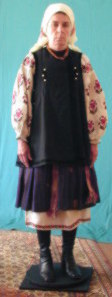A festive sorochka is made
of linen or cotton, though hemp can be used on occasion.
The most prized shifts are made of hand-loomed linen. These
can be identified by the fact that they consist of 3 panels.
Hand-weaving produces a narrow, approximately 18 inch wide,
strip of fabric and three width of this fabric are needed
to make a garment. Garments are pleated at the neck and
at the top and bottom of the sleeves to control the fullness.
A band secures the pleats at the neck and the bottom of
the sleeves. As noted earlier, the bottom is embroidered,
along with the sleeves. The top usually is not embroidered,
though some areas do embroider at the top, sometimes for
decoration and sometimes to secure the garment. Pleat types,
along with other features discussed below, identify the
area in which the garment was made. The garment usually
has a very deep front slit to permit the nursing of children.
The slit is concealed under the korsetka or iubka. If the
garment is not made of hand-loomed fabric, it is usually
made of two pieces, rather than three, and has side seems.
Natalie Kononenko models a festive outfit from the village
of Velykyi Khutir, Drabiv region, Cherkasy province. The
various components of the outfit come from different people.
The shift is hand-loomed linen. The jacket is hand-made
from store-bought fabric. It is cotton with velvet trim
and is lined with hemp. The skirt is also handmade from
store-bought fabric. The belt is hand-woven wool.

